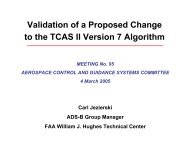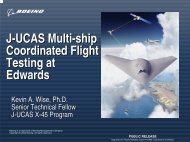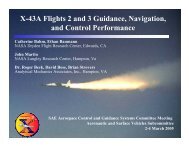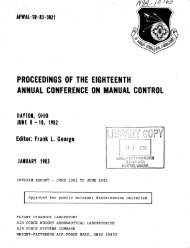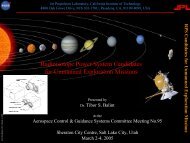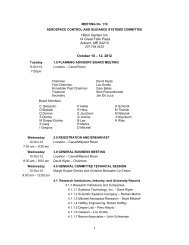Report of the Second Piloted Aircraft Flight Control System - Acgsc.org
Report of the Second Piloted Aircraft Flight Control System - Acgsc.org
Report of the Second Piloted Aircraft Flight Control System - Acgsc.org
Create successful ePaper yourself
Turn your PDF publications into a flip-book with our unique Google optimized e-Paper software.
By way <strong>of</strong> introduction to this problm, I wauld like to revert for<br />
a momsnt to some <strong>of</strong> <strong>the</strong> ideas expressed in <strong>the</strong> axcellent papr we heard<br />
on Tuesdey rnornbg by Mr. Andrm <strong>of</strong> Hughes <strong>Aircraft</strong> and presmted bgT<br />
Mr. Turner. In this paper it was ra<strong>the</strong>r forcibly pointed out that we<br />
are rapidly rea- <strong>the</strong> point where we must design our porn boo&<br />
control system to meet quantitative speclfioatiom concerning both<br />
stability and control. I like to think <strong>of</strong> <strong>the</strong> situation in something<br />
like <strong>the</strong> foIloving light, with a very s-6 analogp. I picture <strong>the</strong> w<br />
control system designer in a position somewhat analog~ls to a &ernyew<br />
old boy in a baseball game. An <strong>the</strong> game start@, <strong>the</strong> o<strong>the</strong>r bags are<br />
all under ten years old; <strong>the</strong> mere presepce <strong>of</strong> our slxtem-year old is emougb .<br />
to throw fear into <strong>the</strong> opposition, Just es in <strong>the</strong> early years <strong>of</strong> pmr boost<br />
system, <strong>the</strong> mere presence <strong>of</strong> <strong>the</strong> control wet= desiepar and a little<br />
imaginetion on his part solved <strong>the</strong> problems. As <strong>the</strong> game plogresses, however,<br />
older boys arrive. Our aixtegt-year-old has to work to get his base hits.<br />
He begha to look amuad for a better bat and tools; he starts to consider<br />
using a little stratem instead <strong>of</strong> <strong>the</strong> previous brute-fome tactics. In an<br />
analogous manner, <strong>the</strong> control systems engineer starts to adopt same <strong>of</strong> <strong>the</strong><br />
servomechanism <strong>the</strong><strong>org</strong>--<strong>the</strong> use <strong>of</strong> Nyquist diagrams that have been mentioned<br />
several times here during <strong>the</strong> past few days, for axample. BLlt unfortunately,<br />
<strong>the</strong> game has not yet stabWed. For, approaching our ballfield are a half<br />
dozm pr<strong>of</strong>essioaal ball players, eager to get into <strong>the</strong> game. Our sMemyear<br />
old is wing to have to call on all his ability if he is to hold his<br />
own. In our inmediate problm, we see <strong>the</strong>se pr<strong>of</strong>essional ball players as<br />
<strong>the</strong> problems associated with our planes flying at a Mach number <strong>of</strong> &5.<br />
If we are to design successflrl power-boost aystams and tactically-capable<br />
aircraft operating at <strong>the</strong>se high speeds, it seerme imperative td us at Purdue<br />
that all available knowledge be brought to bear on <strong>the</strong> problem. We feel<br />
that in a few years, when we are confronted<br />
-<br />
with <strong>the</strong> design <strong>of</strong> <strong>the</strong> power<br />
boost systems for <strong>the</strong>se high-speed aircrafb, <strong>the</strong>re will be no accuse for<br />
us not h a m a understanding <strong>of</strong> <strong>the</strong> problem and a general idea <strong>of</strong> a suitable<br />
approach to <strong>the</strong> aolut ions.<br />
What specifically are <strong>the</strong> problems associated with <strong>the</strong> design <strong>of</strong> a highperformance<br />
power-boost wstem? Thw are in number. We wish to mention<br />
only a few <strong>of</strong> <strong>the</strong>m today in any detail. The problem we have heard most about<br />
at this meeting is <strong>the</strong> design <strong>of</strong> an appropriate artificial feel system. I<br />
feel, howemr, tinat this is only one <strong>of</strong> <strong>the</strong> basic problems. It has received<br />
considerable attention here during <strong>the</strong> past few days principally +cause it<br />
is a problem which is already confronting <strong>the</strong> engineer. Of a perhaps !laore c<br />
basic nature, however, are <strong>the</strong> twin problem <strong>of</strong> stability and control. Indeed,<br />
<strong>the</strong> satisfactory solution <strong>of</strong> <strong>the</strong> artificial feel problm can only be arrived<br />
at in conjunction with at least partial solutions to <strong>the</strong> stability and control -<br />
problems, for <strong>the</strong> artificial feel system is an integral part <strong>of</strong> <strong>the</strong> overall<br />
loop which does determine both <strong>the</strong> relative stability and <strong>the</strong> control charact'eristics<br />
.<br />
What essentially are <strong>the</strong> problems associated with control and stability?<br />
The most pressing problem, it seams to me, is <strong>the</strong> development <strong>of</strong> a more



